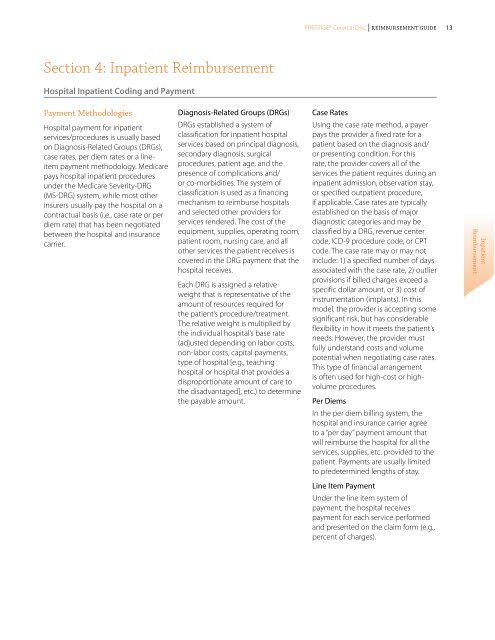Create successful ePaper yourself
Turn your PDF publications into a flip-book with our unique Google optimized e-Paper software.
<strong>PRESTIGE</strong>® Cervical Disc | REIMBURSEMENT GUIDE 13<br />
Section 4: Inpatient Reimbursement<br />
Hospital Inpatient Coding and Payment<br />
Payment Methodologies<br />
Hospital payment for inpatient<br />
services/procedures is usually based<br />
on Diagnosis-Related Groups (DRGs),<br />
case rates, per diem rates or a lineitem<br />
payment methodology. Medicare<br />
pays hospital inpatient procedures<br />
under the Medicare Severity-DRG<br />
(MS-DRG) system, while most other<br />
insurers usually pay the hospital on a<br />
contractual basis (i.e., case rate or per<br />
diem rate) that has been negotiated<br />
between the hospital and insurance<br />
carrier.<br />
Diagnosis-Related Groups (DRGs)<br />
DRGs established a system of<br />
classification for inpatient hospital<br />
services based on principal diagnosis,<br />
secondary diagnosis, surgical<br />
procedures, patient age, and the<br />
presence of complications and/<br />
or co-morbidities. The system of<br />
classification is used as a financing<br />
mechanism to reimburse hospitals<br />
and selected other providers for<br />
services rendered. The cost of the<br />
equipment, supplies, operating room,<br />
patient room, nursing care, and all<br />
other services the patient receives is<br />
covered in the DRG payment that the<br />
hospital receives.<br />
Each DRG is assigned a relative<br />
weight that is representative of the<br />
amount of resources required for<br />
the patient’s procedure/treatment.<br />
The relative weight is multiplied by<br />
the individual hospital’s base rate<br />
(adjusted depending on labor costs,<br />
non-labor costs, capital payments,<br />
type of hospital [e.g., teaching<br />
hospital or hospital that provides a<br />
disproportionate amount of care to<br />
the disadvantaged], etc.) to determine<br />
the payable amount.<br />
Case Rates<br />
Using the case rate method, a payer<br />
pays the provider a fixed rate for a<br />
patient based on the diagnosis and/<br />
or presenting condition. For this<br />
rate, the provider covers all of the<br />
services the patient requires during an<br />
inpatient admission, observation stay,<br />
or specified outpatient procedure,<br />
if applicable. Case rates are typically<br />
established on the basis of major<br />
diagnostic categories and may be<br />
classified by a DRG, revenue center<br />
code, ICD-9 procedure code, or CPT<br />
code. The case rate may or may not<br />
include: 1) a specified number of days<br />
associated with the case rate, 2) outlier<br />
provisions if billed charges exceed a<br />
specific dollar amount, or 3) cost of<br />
instrumentation (implants). In this<br />
model, the provider is accepting some<br />
significant risk, but has considerable<br />
flexibility in how it meets the patient’s<br />
needs. However, the provider must<br />
fully understand costs and volume<br />
potential when negotiating case rates.<br />
This type of financial arrangement<br />
is often used for high-cost or highvolume<br />
procedures.<br />
Per Diems<br />
In the per diem billing system, the<br />
hospital and insurance carrier agree<br />
to a “per day” payment amount that<br />
will reimburse the hospital for all the<br />
services, supplies, etc. provided to the<br />
patient. Payments are usually limited<br />
to predetermined lengths of stay.<br />
Line Item Payment<br />
Under the line item system of<br />
payment, the hospital receives<br />
payment for each service performed<br />
and presented on the claim form (e.g.,<br />
percent of charges).<br />
Inpatient<br />
Reimbursement



